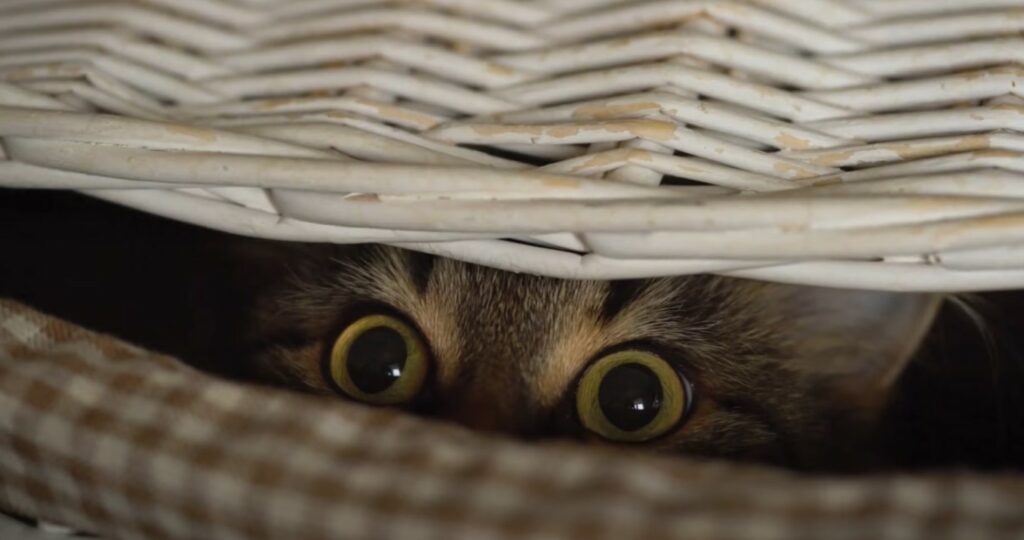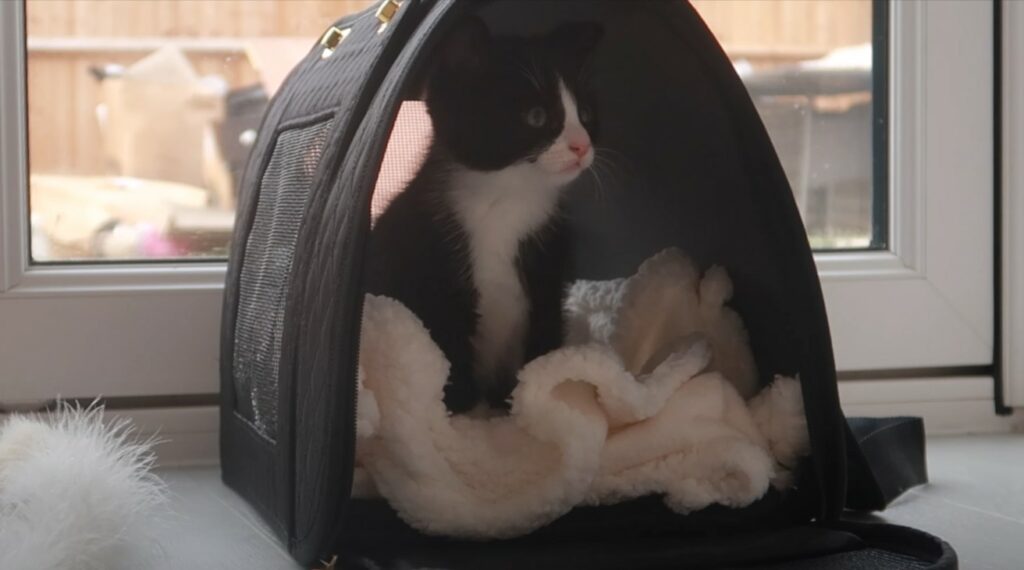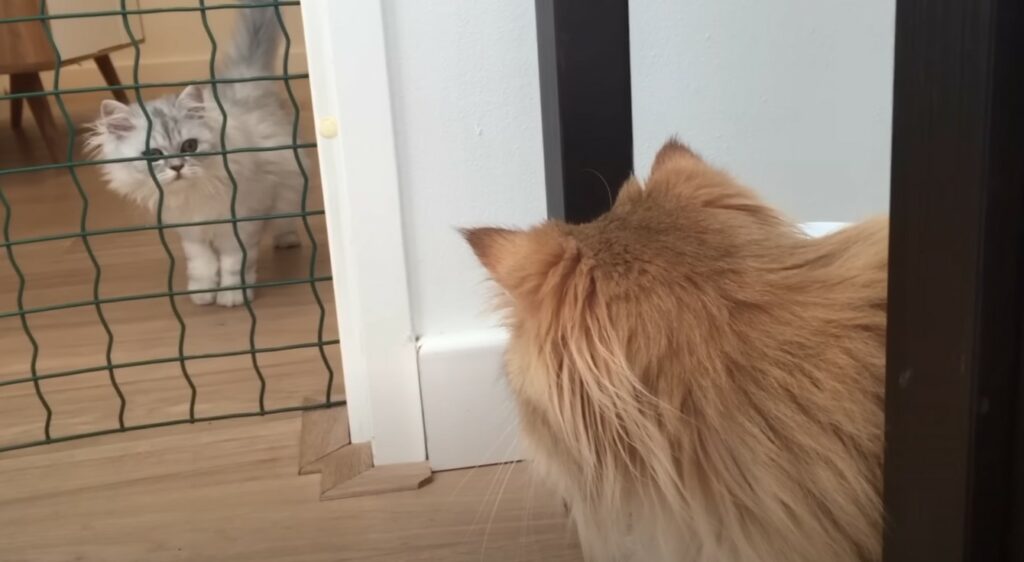Getting lost in the excitement can be easy when first bringing a new cat or kitten home. There’s a new furry member of the family to spoil and entertain, after all. However, allowing time for the new cat to adjust to its new home is essential. This ensures it can settle into its new environment in its own time, and avoiding additional stress from flaunting family members is vital.
Cats usually have an adjustment period of three to five days, extending up to a few weeks if the cat has a nervous or anxious personality. Both adult cats and kittens require time to get used to their surroundings; for adult cats, this means having to adjust to their new surroundings, while kittens will have to do that without the comforting presence of their mum and siblings.
This article will outline the behaviours cats display during the early stages of the transition, the key signs your new cat is adjusting to its new environment, as well as the complications that can arise if there is already a cat in the household.
Table of Contents
5 Behaviours Cats Display During the Transition Period
Kittens often adapt the quickest to a new house; they can be comfortable in an unfamiliar environment as quickly as three days. Adult cats, however, often take longer to adjust. To ensure the settling-in goes well, it is best to limit the cat to one room. This room should be a quiet room and away from the busier areas of the house; a spare room is an excellent choice. It will help the cat relax in a safe space before exploring other rooms of the house.
During the transition period of welcoming a new kitten or cat into your home, there are some behaviours to expect. These are normal for cats to experience as they get used to their new environment, although cat owners can sometimes become concerned as a result.
1. Destructive Behaviour
When a cat is stressed, it can develop destructive tendencies to cope with the situation. By having a designated cat’s room for the new arrival, you can limit the areas of the house that can be damaged. This also means any fragile, important, or valuable items can be removed from the room and put out of the cat’s reach.
Scratching the Carpet, Furniture, or Walls
Cats are well-known for scratching. This can be a way of distributing their scent, removing dead parts of their nails, or expressing emotion, such as excitement or nervousness. Scratching on vertical surfaces, like the arms of furniture and walls, is typically associated with stress, especially if it is a new behaviour.
Knowing this is a new behaviour can be difficult when the cat or kitten has only been in the house a short time. You might want to contact the breeder or organisation you got the kitten or adult cat from to check if the behaviour is new.
As this is a cat’s natural instinct, it might not be possible to alleviate the scratching fully. Instead, try to provide the cat with adequate playtime with yourself and other family members, as well as a sturdy scratching post in the area they’ve been focused on.
Biting and Chewing Furniture or Objects
No one wants cat teeth imprinted all over their house, but this is a possibility when first introducing a cat into your home. Cats can chew on things when they are bored or anxious.
Not only can this cause damage around the house, but chewing can be a health risk for cats. There are many items cats should not chew or try to eat, such as electrical wiring and toxic materials, which should be hidden away if a cat begins to display this type of destructive behaviour.
If your new cat does begin to display this behaviour, investing in some chew toys might help. It will also be worthwhile trying to make it feel safe in the room; this might include providing more hiding places or spending more time with the cat.
2. Hiding
Even the most confident cat can feel safer hiding when first brought home; it’s not unusual for a cat or kitten to retreat, even after being comfortable around you during the first meeting. A new house can be unfamiliar terrain to a cat, making it feel uneasy and causing it to remain hidden for days. Unsurprisingly, hiding is a natural behaviour in these situations.
If your new kitten or cat hides, it is important to give it space until they are more comfortable. This might include giving the cat a suitable hiding place or two. Of course, this doesn’t mean the new kitty cannot become accustomed to its owner’s presence; new cat owners can sit in the same room as their pets, but they should wait for the cats to come to them.
Most cats prefer to hide up high or in tight spaces, which means they can be easy to miss when searching. If you want to avoid this, block off areas you don’t want the cat to have access to, such as behind couches or above wardrobes. It is also important to keep the cat inside during this transition period as it could spook and run away if let outside.

3. Lack of Appetite
The stress of travelling and moving into a new home can cause a cat to stop eating for a few days. During this time, due to not eating, you might notice your new cat has stopped using the litter tray, too. This is normal, as moving is a big deal for such a small animal. As the cat begins to feel more at home, normal eating habits should return.
New kittens and cats might avoid eating for other reasons, such as:
- The food and water bowls are in the wrong location
- They do not like the food bowls
- The bowls might not be clean enough
- They are experiencing toothache
- They have an underlying health issue that causes a lack of appetite
If a cat’s appetite does not return after a few days, cat owners are encouraged to contact their local veterinary practice for advice.
4. Meowing Excessively
Cats can often become more vocal at stressful times. For kittens, they might be trying to locate their mother and littermates. This will likely be their first time away from their cat family, and it can be a disorientating experience. If you can, getting a blanket with the mum’s scent on it might help to calm the kitten down. You might also want to give your kitten extra attention and affection to make it feel safer in its new home.
If your new adult cat won’t stop meowing, this could be a sign of anxiety and discomfort. Moving into a new house will be disorientating for a cat, at least for the first week or so. Their routine has changed considerably just from being in a new place. Just like with kittens, the aim should be to give your cat comfort and make it feel secure.
Other possible causes for nonstop meowing include:
- Being hungry or thirsty
- Wanting attention and comfort
- Illness or injury
- Playful behaviour
- Female cats might be going into heat
On the other hand, there might be no cause for excessive meowing. Some cats are just more vocal than others.
5. Toileting Outside the Litterbox
Cats doing the toilet outside the litter box can be due to unfamiliar surroundings or litter box avoidance. When you first bring your new pet cat home, the litter tray should be the first stop; this will help them to know where it is. It’s important to keep putting the kitten or cat in the litter box until it begins to use it on its own.
Litter box avoidance can be caused by a number of issues, as listed below:
- The cat doesn’t like the litter box location
- The cat doesn’t like the type of cat litter used
- The cat doesn’t like the type of litter tray
- The litter box is not clean
These issues can cause a cat to ignore its litter box in favour of toileting elsewhere around the house. This can happen at any time during a cat’s lifetime, but it is most common when first moving into a new home.
If you have more than one cat in the household, problems can also arise from having too few litter boxes. There should always be more litter boxes than cats in a household; for example, if you own two cats, there should be at least three litter trays. Cats are territorial creatures and will not always share with other cats in the house.
7 Key Signs the Cat is Settling into the New Home
As time progresses, the new cat will begin to settle into its new home. This can take longer for adult cats than kittens, but it can be made easier by ensuring the cat is comfortable and kept secure.
The following signs will show that your new cat is beginning to adjust to its new environment.
1. Depositing Their Scent
Cats will start to rub themselves, especially their heads and necks, against surfaces around the house to deposit their scents. This is basically claiming the territory as their own. It also helps cats to make them feel more comfortable as they are surrounded by their own scent.
2. Exhibiting Positive Body Language Behaviors
Once cats feel comfortable in their new homes, their body language will change. Where they might have previously displayed signs of stress, such as flat ears and wide eyes, cats might begin to:
- Jump up for attention – If a cat hops up to greet its owner, it’s asking for attention.
- Roll onto its back to expose its belly – This is a sign of trust, not an invitation to rub its belly.
- Slow blink or have soft eyes – Half-closed and slow-blinking eyes are signs of relaxation and friendliness.
- Walk with an upright tail – If a cat approaches you with an upright tail, this means it is happy to see you.
3. Exploring Their Surroundings
Once a cat stops hiding, it will begin to move around the available areas slowly. Cats are very curious and will try to explore all corners of the house, but this should be controlled – widen the area the cat can access from just one room to two rooms and so on. This will stop the cat from becoming overwhelmed or stressed again.
As the cat gains more confidence and has access to the whole house, it’s essential to ensure everywhere has been cat-proofed. This means no wires are available for chewing or pulling at, windows are closed, and items are out of reach if you do not want the cat near them.
Other members of the household will have to remain calm and quiet during this time, too, including any other pets. This might be tough for houses with dogs, but they can be introduced to the new cat slowly to avoid rushed and frightening meetings. It’s critical the cat can explore its new home in its own time.

4. Grooming
A cat with a healthy coat is a happy cat. If regular grooming remains a priority for your new cat or kitten, it is safe to say that the cat is relatively content in its new home. Stress can cause a cat to stop grooming itself, which may cause its coat to look dull and messy.
This is especially true if your cat grooms itself in front of you. A cat that can sit in the middle of a room and groom itself is fully at ease in its home.
5. Normal Appetite
If stress has caused your new cat to stop eating or eat less than desired, this should return to normal as it settles into its new environment. Cats should begin to search for food or become increasingly interested in mealtimes; in fact, some cats will begin to remind their owners when it’s dinnertime by meowing.
Cat owners should have a variety of food to try with their pets. The breeder or organisation will likely have said a particular brand or type of food, but cats enjoy variety. This means you can provide them with dry and wet food, in jelly or in gravy, poultry or fish, etc.
6. Not Urinating Outside The Litter Box
As previously mentioned, most cats will avoid the litter box if they feel stressed or unhappy with its location, type, or the litter within. You might need to put the litter tray in various locations around the house until the cat feels comfortable, and the litter might need to be changed a few times to find one the cat likes.
However, once the cat is comfortable, they will begin to use the litter box. This is often the step owners are most happy about, which means there will be no surprising mess around the house.
7. Playfulness
A good sign of settling in is playfulness. Cats can spend days hiding from their new owners, barely acknowledging their presence as they hide in the small nooks and crannies available to them. Eventually, with some patience and time, the cats will begin to explore and become interested in playing with their owners and any cat toys that are lying around.
If the cat has been properly introduced to other pets in the house, it might even display playful behaviour towards them. Introductions with other animals in the household, especially cats, should be done slowly and with proper care to prevent injury.
Issues When Adding a Cat to a House with an Existing Cat
Introducing a new kitten or cat to the resident cat of the house can become a stressful situation. It requires proper preparation. Cat owners should research the correct way to introduce cats to ensure they avoid unnecessary dangers and avoid any of the cats becoming injured. It is often easier to introduce a new kitten to an older cat, as there is less competition this way. Cats that have been neutered or spayed will also be more willing to live in a multicat household, but this is not guaranteed.
In some cases, the kitten or cat will have already been socialised with other cats, which might make this situation easier.

Still, introductions must be carried out slowly and in a controlled environment, where the owner can step in to stop aggression. The easiest way is to keep the cats in separate rooms, allowing them to sniff each other through a door, then see each other briefly, and finally, letting the cats spend time together. Although you may believe your cat will take to a new cat easily, it’s vital to make introductions over a few weeks. Even friendly cats can become aggressive if they feel threatened.
Some issues that can arise when adding a second cat to the household include:
- The cats might start fighting
- One or both cats might begin hiding constantly
- The cats might avoid their litter trays
- They might refuse to eat
- One or both cats might start spraying and marking rooms to claim territory
Even the current cat may experience these issues, not just new cats.
To Sum Up
Helping a new cat settle into its forever home can be a long but worthwhile process. It requires patience, time, and a lot of understanding to make the cat feel comfortable and relaxed at its own pace. Cats can be very sensitive to change, so entering a new space can be overwhelming and cause them to display signs of stress, such as destructive behaviour, hiding, and litter box avoidance. During this time, it is important to give the cat space.
Eventually, however, these stress-induced behaviours will lessen, and the cat will become more comfortable in its new surroundings. It will begin to show signs your new cat is adjusting to its home, becoming more relaxed and playful. There may be complications if there is already a cat in the household, though.
The information discussed in this article is essential to know when it comes to bringing your new feline friend home. So, this article will hopefully prepare you so the transition is a breeze.

